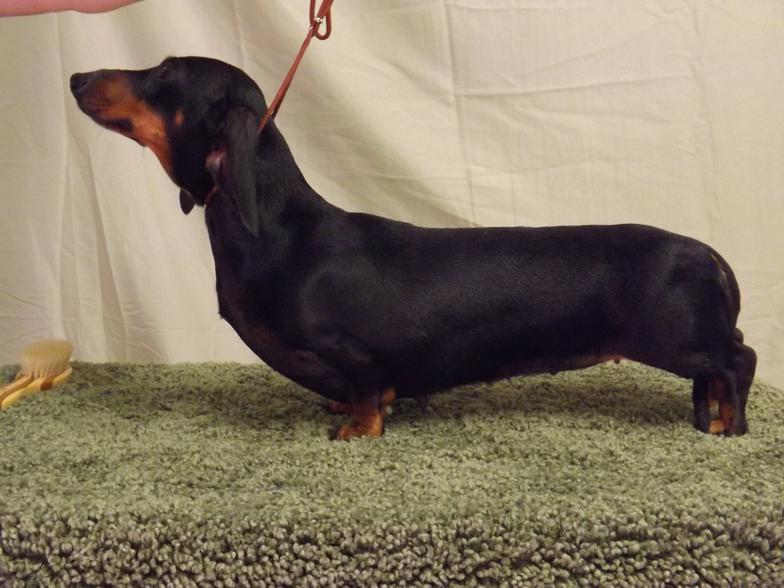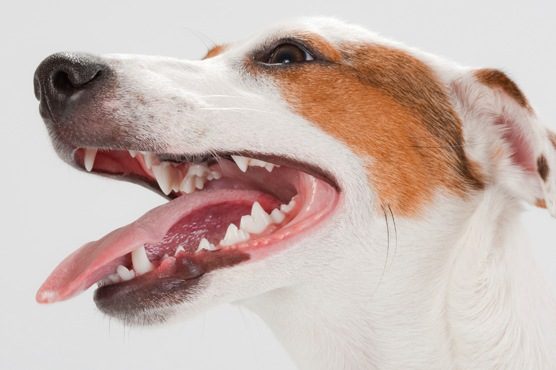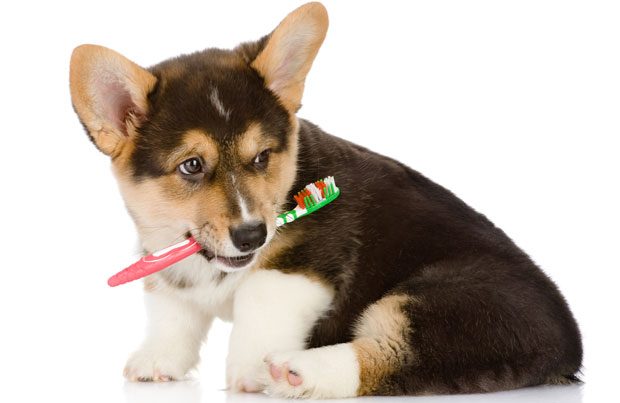If you have a small dog, there’s a pretty decent chance that during one of our appointments we have told you something about “loose teeth” “gum recession” “crowding” or any number of other things–or we’ve told you to go straight to the vet, come back for cleanings every 6 months. There’s a reason that a huge portion of the dogs we see (and refer to the vet) are small breeds, and that’s because smaller dogs overall tend to have worse dental health than their larger counterparts.
“But why is this?” is the biggest question we get. And I’m happy to tell you why!
Multiple factors influence a dog’s dental health, and many of them start even before the dog is born. The genetic build of your dog makes a huge impact on their dental health. Many small and toy breeds today have had their most drastic conformation and appearance changes within the past 200 years (give or take). Just look at this painting of a Dachshund at the end of the 19th century!
-

Dachshunds then… -

…Dachshunds now!
This quick change has left little time for these breeds to adapt naturally, and selective breeding has played the biggest role in this. With the first dog shows happening in Britain in the 1850s and the founding of the UK Kennel Club in 1873, strict breed standards were put into place and emphasized exaggerated features in many breeds–which led to dogs like the Dachshund above losing their compact and muscular frame, with strong running legs in favour of dogs that now have extra-elongated backs that get frequently injured and legs that are so short that even healthy dachshund’s bellies can drag on the ground. This emphasis on having the “perfect breed look” also led to breeders relying on close inbreeding to make puppies that were nearly assured to be perfectly conformed. As we know now, inbreeding so closely and so frequently can lead to debilitating health issues that can sometimes be internal and not seen or expressed until later on in life. Now we know better, but unfortunately a stronger knowledge of genetics and the effects of inbreeding on dog’s health has been lost on some breeders who breed mass amounts of dogs with minimal health care for the maximum profit–puppy mills.
Due to these selective breeding efforts and the popularity of certain breeds increasing, with an emphasis on the dogs with exaggerated traits, many breeds have suffered overall. With small dogs, many of which over the past few hundred years have bred to be much smaller with each generation, the skulls have shrunk and malformed a huge amount but the teeth have tried to be the same size.
Overall, smaller dogs have bigger teeth relative to the size of their mouth than even wolves; However some breeds like the Jack Russell and Corgi are old enough breeds that have not changed too much in the past century with regards to their head shape that their teeth are still relatively strong and are in proportion with the size of their heads and jaws.

This issue with bigger teeth relative to jaw size has huge implications that we can see on the surface, but also affect what is going on underneath the gums. On the surface, we see small breeds with lots of teeth crowded together, not spaced out nicely enough to allow the root to be strong and grow properly. We also see these teeth scraping against one another when the jaw closes, causing potential gum injuries and recession. The close placement of these teeth to one another also creates many more hard crevices and divots that tartar can build up in, tartar that is very difficult to remove even with a scaler! The more tartar builds up and hardens in the mouth, and the more the gums are affected–which is what leads to dental issues.
Underneath the surface, crowded teeth seem a lot more sinister. With the roots of the teeth being overall larger than the tooth itself, the roots of close teeth have very little space between them for the actual bone of the jaw to grow. This means that when the roots of the teeth start to be affected by things like periodontal disease and have to be extracted by a veterinarian, there ends up being very little jaw left as support–which has many dire implications for the future of your dog’s oral health.

The crowding of the teeth starts affecting a dog right from the start. When your dog is about 6 or 7 months old, they start losing their 28 baby teeth and start growing in their 42 big, strong adult teeth. Many dogs don’t grow in some small premolars because they become embedded in the gum from crowding, and many still end up having baby teeth still in the jaw later in life–far after they should have fallen out! Veterinarians will mostly pull any remaining baby teeth if your pet is spayed or neutered around this age, but if they are spayed or neutered earlier and never go in for deep dental cleanings at the vet, these teeth can remain around for a long time causing problems in your dog’s mouth. Retained puppy teeth may cause the adult teeth to grow in at an incorrect angle which can misalign your dog’s bite and permanently affect their oral health. Worst case, the remaining baby tooth can get infected and that infection can spread to the surrounding teeth to create a dental nightmare that will cost a hefty sum to fix.
If your dog is small and brachycephalic (short snouted), then the issues compound further. Brachycephalic (literally meaning ‘short-head’) dogs have skulls that have gone through intense selective breeding to create a more ‘cute’, rounded shape that emphasizes big eyes, a flat nose, a protruding forehead, and a huge underbite. We all love Frenchies, Pugs, Pekes, you name it! They are wonderful dogs! But unfortunately, the way they are made causes them huge problems orally. Look at the difference between these dog skulls:

That’s crazy! The Peke’s upper canine teeth overlap halfway down the bottom jaw, where they should sit right behind the lower canine teeth like in the Husky and the Wolf. The upper incisors on the English Bulldog line up with the 2nd premolar on the bottom jaw, where they would normally be perfectly aligned with the lower incisors. Just from this one image it is clear to see that these dog’s jaws are severely misaligned, and all of these brachycephalic breeds have massive underbites. When the teeth are so badly misaligned, it means that when the dog chews and bites the teeth don’t meet properly, and the scraping action they have against the opposing teeth and their treats doesn’t happen. This leaves those misaligned teeth with huge amounts of tartar on them. Not to mention the fact that the teeth of the upper jaw are so much more crowded than the lower jaw, which as mentioned before will create lovely pockets for tartar to invade.
Overall, the takeaway is that small breeds of dogs were bred for looks and companionship, and not for their dental health. These breeds are wonderful and no one who has one would trade them for the world, for sure–but it’s important to know what affects their dental health, and how. Knowing this we can take care of our individual dogs’ oral health better, and advocate for responsible breeding practices that ensure that the descendents of these dogs are getting better teeth than their predecessors.
As we tell everyone, brushing is the number 1 defence against tartar buildup and gum recession. If you have a small breed or brachycephalic breed (or both!), dental supplements can certainly help you keep on top of your pet’s oral health on top of regular brushing, providing healthy chews, and regular dental cleanings. Although we are happy to provide anesthesia-free teeth cleaning for your dog provided they can tolerate it and don’t have any dental issues we would want a vet to address, most small and/or brachycephalic breeds of dogs will need dental cleanings under anesthetic at some point in their life to address the issues that they couldn’t help but be born with.

By Matthew Staton
SOURCES:
https://pethelpful.com/dogs/Your-Maltese-and-Periodontal-Disease
https://www.petmd.com/dog/general-health/5-scary-consequences-neglecting-your-dogs-teeth
https://vcahospitals.com/know-your-pet/retained-deciduous-teeth-baby-teeth-in-dogs
https://wagwalking.com/symptom/why-is-my-dog-missing-teeth
https://healthypets.mercola.com/sites/healthypets/archive/2018/04/11/dog-dental-health.aspx
https://dogtime.com/dog-health/34861-dog-breeds-worst-teeth
https://www.petguide.com/health/dog/small-breed-dogs-susceptible-tooth-loss/
